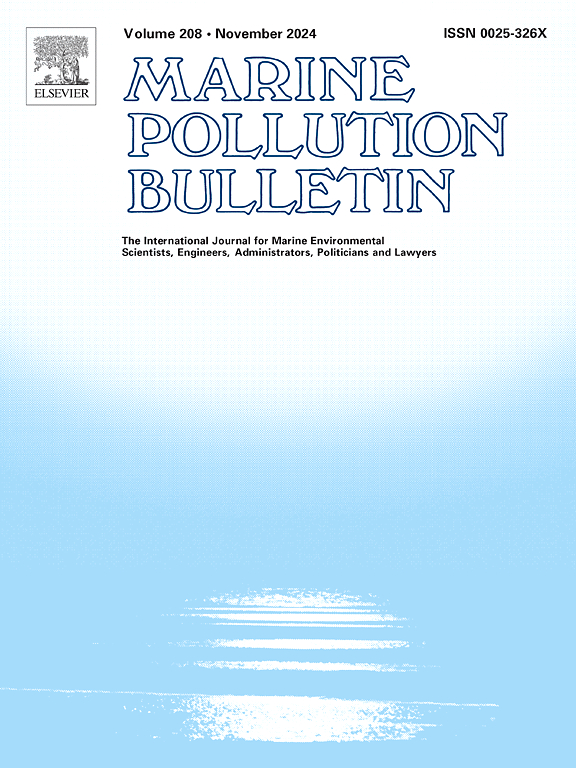西加勒比海Roatán红树林土壤中的海洋垃圾:丰度、来源和美洲鳄(Crocodylus acutus)的摄食
IF 4.9
3区 环境科学与生态学
Q1 ENVIRONMENTAL SCIENCES
引用次数: 0
摘要
岛屿地区的红树林越来越多地暴露在海洋垃圾中,即使在指定的保护区内也是如此。这些生态系统提供关键的生态服务,但仍然容易受到固体废物积累造成的污染。特别是加勒比红树林在全球评估中的代表性不足。本研究提供了宏都拉斯湾群岛国家海洋公园Roatán岛上红树林大凋落物积累的第一个基线。我们评估了:(1)4个红树林样地大型凋落物(≥5 cm)的丰度和组成;(2)通过对标签物品的品牌和原产国进行分析,确定宏观塑料的潜在来源;(3)在一个地点附近发现的美洲鳄(Crocodylus acutus)所摄入的垃圾成分。20个样方共收集凋落物3417样,平均浓度为6.83样m−2。塑料是垃圾的主要成分,占所有垃圾的98.7%。只有2.4%的物品有清晰的标签,大多数来自洪都拉斯和危地马拉。在有可见日期的瓶子子集中,平均年龄为7年,表明在红树林环境中可以长期保存。在其中一个地点附近发现的死亡尖耳镰刀虫吞食了62个垃圾。主成分分析显示,摄入物质的组成与附近采样点的凋落物剖面密切匹配,表明可能是局部暴露。这些发现证实了红树林是塑料的长期水槽,并强调了红树林动物群面临的风险。被禁的垃圾和来自外国的垃圾凸显了执法不力和跨境污染。迫切需要协调区域政策、改善废物管理和有针对性地清理受保护的生态系统。本文章由计算机程序翻译,如有差异,请以英文原文为准。
Marine litter in mangrove soils of Roatán, Western Caribbean: Abundance, sources, and ingestion by an American crocodile (Crocodylus acutus)
Mangrove forests in insular regions are increasingly exposed to marine litter, even within designated protected areas. These ecosystems provide key ecological services but remain vulnerable to pollution via solid waste accumulation. Caribbean mangroves, in particular, are underrepresented in global assessments. This study provides the first baseline of macrolitter accumulation in mangroves on Roatán Island, within the Bay Islands National Marine Park, Honduras.
We assessed: (1) the abundance and composition of macrolitter (≥5 cm) across four mangrove sites; (2) potential sources of macroplastics through brand and country-of-origin analysis of labeled items; and (3) the composition of litter ingested by an American crocodile (Crocodylus acutus) found near one site.
A total of 3417 litter items were collected across 20 quadrats, with an average concentration of 6.83 items m−2. Plastics dominated the litter, making up 98.7 % of all items. Only 2.4 % items had legible labels, most originating from Honduras and Guatemala. Among the subset of bottles with visible dates, the average age was 7 years, suggesting long-term retention within the mangrove environment. The deceased C. acutus found near one of the sites had ingested 62 litter items. A Principal Component Analysis revealed that the composition of ingested materials closely matched the litter profile of the nearby sampling site, indicating likely local exposure.
These findings confirm that mangroves act as long-term sinks for plastic and highlight risks to mangrove fauna. The presence of banned and foreign-sourced litter underscores poor enforcement and transboundary pollution. Coordinated regional policies, improved waste management, and targeted cleanup in protected ecosystems are urgently needed.
求助全文
通过发布文献求助,成功后即可免费获取论文全文。
去求助
来源期刊

Marine pollution bulletin
环境科学-海洋与淡水生物学
CiteScore
10.20
自引率
15.50%
发文量
1077
审稿时长
68 days
期刊介绍:
Marine Pollution Bulletin is concerned with the rational use of maritime and marine resources in estuaries, the seas and oceans, as well as with documenting marine pollution and introducing new forms of measurement and analysis. A wide range of topics are discussed as news, comment, reviews and research reports, not only on effluent disposal and pollution control, but also on the management, economic aspects and protection of the marine environment in general.
 求助内容:
求助内容: 应助结果提醒方式:
应助结果提醒方式:


